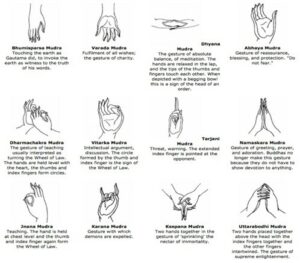3 July 2024 : Daily Current Affairs
1. Rahul Gandhi’s Abhayamudra Gesture: A Call for Fearlessness in Indian Politics
- 1. Rahul Gandhi’s Abhayamudra Gesture: A Call for Fearlessness in Indian Politics
- 2. Ministry of Mines Plans PLI Scheme to Boost Critical Mineral Recycling in India
- 3. Strong Export Performance by India and China Boosts Global Trade in Early 2024: UNCTAD Report
- 4. On improving rural mobile connectivity
- 5. Iran: limited democracy, unlimited theocracy
- 6. Santhal Hul of 1855: A Historic Revolt Against British Imperialism and Local Exploitation
- 1. Tirzepatide Set to Enter Indian Market Pending Final Approval: A Breakthrough in Diabetes and Weight Loss Treatment
- 2. Worrying spread of water hyacinth in Kerala’s Vembanad lake.
- 3. Advanced medium combat aircraft prototype expected to be ready by 2028-29
(Source: Indian Express; Section: Explained; Page: 09)
| Topic: GS1 – History – Indian Culture |
| Context: |
|
Analysis of News:
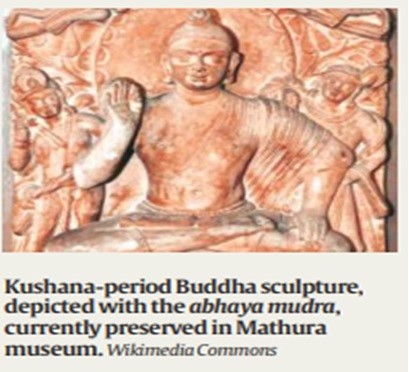
The Symbolism of Abhayamudra:
- The abhayamudra, characterized by a raised open palm, is a gesture that transcends religious boundaries.
- Gandhi pointed out that this gesture appears in depictions of Lord Shiva, Guru Nanak, Jesus Christ, and figures in Islam, Buddhism, and Jainism.
- It symbolizes fearlessness and reassurance, embodying a fundamental aspect of human spirituality across different cultures.
Mudras in Buddhism:
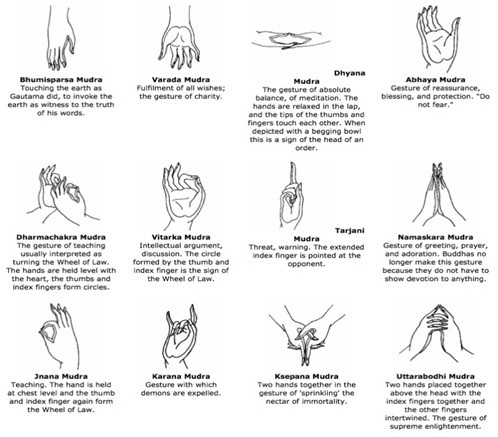
Definition and Historical Context:
- In Buddhism, the term mudra refers to specific hand and arm gestures made during rituals or depicted in images of religious figures. These gestures convey different meanings and moods, representing the various states of realization of the Buddha.
- For approximately 500 years after the Buddha’s time, he was not depicted in physical form; instead, symbols like a vacant throne or footprints represented him.
Evolution and Significance:
- The earliest physical depictions of the Buddha began around the turn of the first millennium, influenced by the Gandhara art of the northwestern Indian subcontinent and the Gupta period art in the Gangetic plains.
- Four primary mudras emerged in early Buddhist art: the abhaya mudra (gesture of fearlessness), the bhumisparsha mudra (Earth-touching gesture), the dharmachakra mudra (gesture of the wheel of dharma), and the dhyana mudra (gesture of meditation).
Tantric Buddhist Traditions:
- With the evolution of Mahayana and Vajrayana Buddhism, numerous mudras were incorporated into Buddhist iconography.
- In tantric traditions, these mudras became associated with dynamic ritual hand movements, symbolizing material offerings, forms of worship, or relationships with visualized deities.
The Gesture of Fearlessness:
Description and Cultural Context
- The abhaya mudra is typically formed with the right palm facing outward at shoulder height, fingers pointing up.
- Sometimes, both hands may be raised in a double abhaya mudra. In Buddhist tradition, this gesture is linked to the Buddha’s enlightenment, symbolizing security, serenity, and compassion.
Legend and Significance
- A famous Buddhist legend describes the Buddha using the abhaya mudra to calm a mad elephant sent to attack him by his cousin Devadatta.
- The Buddha’s gesture of fearlessness and compassion pacified the elephant, demonstrating his ability to grant fearlessness to his followers.
- Consequently, the abhaya mudra is also seen as a gesture of protection and granting refuge.
Abhayamudra in Hindu Religion:
Integration and Depictions
- Over time, the abhaya mudra appeared in Hindu religious iconography, particularly in depictions of deities such as Lord Shiva, Lord Vishnu, and Lord Ganesha.
- The Buddha himself was absorbed into the Hindu pantheon as an avatar of Vishnu. The first mention of the Buddha avatar appears in the Vishnu Purana, around 400-500 CE.
Symbolic Convergence:
- The abhayamudra’s presence in both Buddhist and Hindu traditions illustrates the convergence of multiple religious practices and cultural influences in India.
- It became a common motif in the artistic and visual representation of gods, symbolizing protection, reassurance, and the overarching theme of fearlessness.
Conclusion: The Universal Message of Abhayamudra:
- Rahul Gandhi’s invocation of the abhayamudra in his speech underscores its deep-rooted significance across various religious and cultural traditions.
- This gesture of fearlessness and protection serves as a powerful symbol against a culture of fear, aligning with the core values of confronting and overcoming fear that are central to Indian civilization and spirituality.
| What is Mudra in Buddhism? |
|
In Buddhism, mudras are hand gestures or positions that are used during meditation and other practices to help focus the mind, channel energy, and deepen one’s connection to the teachings. Here are some of the mudras commonly used in Buddhism:
|
|
PYQ: Lord Buddha’s image is sometimes shown with the hand gesture called ‘Bhumisparsha Mudra’. It symbolizes (2012) (a) Buddha’s calling of the Earth to watch over Mara and to prevent Mara from disturbing his meditation (b) Buddha’s calling of the Earth to witness his purity and chastity despite the temptations of Mara (c) Buddha’s reminder to his followers that they all arise from the Earth and finally dissolve into the Earth, and thus this life is transitory (d) Both the statements (a) and (b) are correct in this context Ans: (b) |
| Practice Question: Discuss the historical and cultural significance of the abhayamudra across various religious traditions. How can this gesture be interpreted in the contemporary political context of India? (250 words/15 m) |
2. Ministry of Mines Plans PLI Scheme to Boost Critical Mineral Recycling in India
(Source: Indian Express; Section: Economy; Page: 13)
| Topic: GS3 – Indian Economy – Issues relating to mobilization of resources. |
| Context: |
|
Analysis of News:
What is the Production Linked Incentive Scheme (PLI)?
- The PLI scheme was conceived to scale up domestic manufacturing capability, accompanied by higher import substitution and employment generation.
- Launched in March 2020, the scheme initially targeted three industries:Mobile and allied Component ManufacturingElectrical Component Manufacturing andMedical Devices.
- The scheme is currently active in 14 key sectors: mobile manufacturing, manufacturing of medical devices, automobiles and auto components, pharmaceuticals, drugs, specialty steel, telecom & networking products, electronic products, white goods (ACs and LEDs), food products, textile products, solar PV modules, advanced chemistry cell (ACC) battery, and drones and drone components.
- Under PLI scheme, Domestic and Foreign companies receive financial rewards for manufacturing in India, based on a percentage of their revenue over up to five years.
Aligning with Policy Recommendations:
- The proposed PLI scheme aligns with policy recommendations from NITI Aayog, the government’s apex think tank, and complements the Battery Waste Management Rules (BWMR), 2022.
- These rules mandate phased recycling of used electric vehicle (EV) lithium-ion batteries from 2026 onwards, promoting sustainable practices in the industry.
Targeting E-Waste Recycling:
- The PLI scheme will focus on e-waste recycling, often referred to as “urban mining,” to recover critical minerals such as lithium, copper, cobalt, graphite, chromium, and silicon.
- These minerals are essential for clean energy technologies like solar PV modules, wind turbines, energy storage systems, and EVs, as well as consumer electronics.
Incentives and Investment in Recycling Technologies:
- Similar to other PLI schemes, the Mines Ministry’s initiative will incentivize the production of recycled critical minerals for secondary use and promote investment in advanced recycling technologies and infrastructure.
- The amount of incentive will likely vary based on the type and value of the minerals recycled.
Industry Perspectives and Scope of the Scheme:
- Some recyclers believe the scheme should benefit those extracting high-purity critical minerals suitable for reuse as primary inputs.
- Others advocate for a broader scope that includes the production of black mass, which is processed e-waste rich in minerals.
- Most Indian recyclers currently lack the capacity to extract battery-grade minerals from black mass, highlighting the need for technological advancements.
Surge in E-Waste Generation:
- India’s e-waste generation is expected to increase significantly due to the rapid growth of solar and wind energy infrastructure and EV adoption.
- Industry estimates project solar PV module waste to rise from 100 kilotonnes (kt) in FY23 to 340 kt by 2030, and 500 kt of EV batteries are expected to reach recycling units in the coming years.
- Recycling critical minerals can significantly reduce the need for virgin ores and new mines.
Recommendations from NITI Aayog:
- A report released by NITI Aayog in July 2023 advocated for a PLI scheme for critical mineral recycling.
- The think tank emphasized the importance of parameters such as cell chemistry, recovery efficiency, and benchmarks for domestic utilization of recovered minerals.
- These recommendations aim to support domestic recyclers and cell manufacturers under the ACC PLI scheme.
Urgency and Investor Interest:
- The need to incentivize the growth of critical mineral recycling has become urgent after most critical mineral blocks offered by the Mines Ministry failed to pass the technical bids stage, indicating a lack of investor interest in domestic mining.
- The new incentives will build on the Battery Waste Management Rules (BWMR) and promote Extended Producer Responsibility (EPR) compliance, ensuring producers manage waste generated by their products.
Conclusion: Building a Sustainable Future
- The PLI scheme for recycling critical minerals represents a significant step towards fostering a circular economy and strengthening India’s supply chains for clean energy technologies.
- By aligning with policy recommendations and promoting advanced recycling technologies, the initiative aims to address the challenges faced by the industry and support the growth of a sustainable, environmentally responsible economy.
| Why Critical Minerals are Important for India? |
|
Foundation of Modern Technology:
Energy Transition:
Futuristic Economy:
Self Reliance:
|
|
PYQ: Recently, there has been a concern over the short supply of a group of elements called ‘rare earth metals’. Why? (2012) 1) China, which is the largest producer of these elements, has imposed some restrictions on their export. 2) Other than China, Australia, Canada and Chile, these elements are not found in any country. 3) Rare earth metals are essential for the manufacture of various kinds of electronic items and there is a growing demand for these elements. Which of the statements given above is/are correct? (A) 1 only (B) 2 and 3 only (C) 1 and 3 only (D) 1, 2 and 3 Ans: C |
| Practice Question: The Ministry of Mines is planning to introduce a Production Linked Incentive (PLI) scheme to enhance the recycling of critical minerals in India. Discuss the significance of such a scheme in fostering a circular economy and strengthening domestic supply chains. What challenges might arise in its implementation, and how can they be addressed? (250 words/15 m) |
3. Strong Export Performance by India and China Boosts Global Trade in Early 2024: UNCTAD Report
(Source: Indian Express; Section: Economy; Page: 13)
| Topic: GS2 – International Relations |
| Context: |
|
Analysis of News:
About UNCTAD:
- United Nations Conference on Trade and Development (UNCTAD) is a permanent intergovernmental body of the United Nations.
- It was established in 1964 and is headquartered in Geneva, Switzerland.
- It aims to promote sustainable development, particularly in developing countries, through international trade, investment, finance, and technology transfer.
UNCTAD’s work focuses on four main areas:
- Trade and development,
- Investment and enterprise
- Technology and innovation
- Macroeconomics and development policies.
Positive Trends in Global Trade
Gradual Increase in Global Trade:
- Global trade experienced a modest and gradual increase in the first quarter of 2024, continuing the positive momentum from the latter half of 2023.
- This growth is attributed to positive trade dynamics in the US, underpinned by moderating inflation and an improving economic growth forecast.
- The UNCTAD report underscores the significance of these factors in reversing the downward macroeconomic trends that characterized much of 2023.
Strong Export Performance by China and India
- China and India demonstrated very strong quarter-over-quarter export performance, significantly contributing to the overall improvement in global trade.
- The report notes that exports also grew for the Russian Federation and the United States, while imports increased for Brazil, the Russian Federation, and the US.
- However, not all major economies shared in this positive trend; Japan and South Africa saw continued declines in trade.
Factors Contributing to Trade Growth:
Influence of Moderating Inflation and Economic Growth:
- Moderating global inflation and positive economic growth forecasts have played a crucial role in boosting trade.
- These factors suggest a reversal of the adverse macroeconomic conditions prevalent in 2023.
- Additionally, the rising demand for products related to energy transition and artificial intelligence is expected to further drive trade growth throughout 2024.
Impact of Heavy Subsidies and Trade Concentration:
- The report highlights an emerging trend where global supply is becoming increasingly concentrated among a few major exporters, bolstered by substantial subsidies.
- While this enhances the global competitiveness of developed countries and major emerging economies, it also marginalizes smaller economies, potentially hurting global trade diversity.:
Risks and Challenges Ahead:
Geopolitical Tensions and Rising Costs:
- Despite the positive outlook, the global trade forecast for 2024 remains subject to significant downside risks.
- Persistent geopolitical tensions, rising shipping costs, and emerging industrial policies could negatively impact global trade.
- The report warns that these factors could lead to trade fragmentation and increased protectionism.
Potential for Inflation and Trade Fragmentation:
- UNCTAD’s report indicates that while prices for traded goods remained constant in the first quarter of 2024, they are expected to rise in the second quarter.
- This could fuel inflation and result in trade growing faster in value than in volume. Additionally, the ongoing subsidy race among major economies could lead to trade fragmentation, as countries vie for dominance in key sectors.
Distortion from Industrial Policies:
- The report also highlights the potential distortions caused by unilateral industrial policies.
- Heavy subsidies provided by developed countries and major emerging economies could enhance their global competitiveness, but at the cost of marginalizing smaller economies.
- Such actions may provoke trade restrictions and retaliatory measures, undermining the rule-based global trading system.
Conclusion
- The UNCTAD report presents a cautiously optimistic outlook for global trade in 2024, driven by strong performances from key economies like China and India.
- However, the potential risks posed by geopolitical tensions, rising costs, and trade fragmentation cannot be overlooked.
- Ensuring a balanced and inclusive global trade environment will require addressing these challenges while fostering cooperation among all economies.
| Practice Question: Examine the factors contributing to the strong quarter-over-quarter export performance of India and China in the first quarter of 2024, and discuss the potential risks and challenges to global trade highlighted in the UNCTAD report. (250 words/15 m) |
4. On improving rural mobile connectivity
(Source – The Hindu, International Edition – Page No. – 10)
| Topic: GS3 – Science and Technology |
| Context |
|
Introduction to Mobile Devices and Cellular Networks
- Mobile devices are essential for communication, financial transactions, and Internet connectivity.
- Connectivity for these devices is facilitated via cellular (mobile) wireless networks.
- Cellular networks, such as 5G, consist of network equipment connected by communication links to move data between devices and other networks like the Internet.
- A cellular network is divided into two sub-networks: the Access Network (AN) and the Core Network (CN).
Access and Core Networks
- The Access Network (AN) includes base stations that provide wireless connectivity to mobile devices in a specific geographical area.
- Base stations, often seen as towers with antennas, are installed by network operators across the region.
- The Core Network (CN) connects to other networks, like the Internet, and operates centrally, far from base stations.
- The CN is linked to base stations by optical fiber links called backhauls. Data from users’ devices pass through both a base station and the CN to reach its destination.
- The CN supports user mobility, a key feature of cellular networks.
Challenges in Rural Connectivity
- Cellular networks are less prevalent in rural areas compared to urban areas, especially in developing countries like India.
- Urban tele-density in India is 127%, while rural tele-density is 58%, indicating a digital divide.
- Lower income in rural areas makes mobile services unaffordable for many residents.
- Rural areas have lower population density, clusters of populations separated by vast spaces, and remoteness, complicating infrastructure deployment.
- Deploying fibre infrastructure to remote villages is often not cost-effective or easy.
IEEE 2061-2024 Standard
- The IEEE 2061-2024 standard, developed by researchers at IIT Bombay, defines a wireless network architecture for affordable broadband access in rural areas.
- The standard includes both a CN and AN but features a heterogeneous AN with different types of base stations.
- The macro base stations (macro-BS) cover large areas with possibly lower data rates, while Wi-Fi within villages provides high-speed connectivity.
- The system allows seamless movement from Wi-Fi to macro-BS connectivity without service disruption, facilitated by integrated AN control functionality.
- The standard accommodates legacy and new technologies like 4G, 5G, 6G, Wi-Fi, and others, ensuring smooth coexistence.
Middle-Mile Network
- The IEEE 2061 standard proposes a multi-hop wireless middle-mile network to extend connectivity to areas lacking optical fibre links.
- This middle-mile network offers cost-effective connectivity over long distances, using technologies like satellites or long-range Wi-Fi.
- Unlike traditional 4G/5G networks, the IEEE-2061 AN can provide direct Internet connectivity, bypassing the CN, which is more suitable for stationary rural users.
- Communication between nearby users can be directly routed within the AN, avoiding the CN, similar to a direct route between nearby cities.
Conclusion
- The IEEE 2061-2024 standard is a significant development in providing affordable connectivity to rural populations.
- Its innovative concepts, including the CN bypass and integrated AN control, may lead to scalable mobile networks in the future.
| PYQ: What is the status of digitalization in the Indian economy? Examine the problems faced in this regard and suggest improvements (150 words/10m) (UPSC CSE (M) GS-3 2023) |
| Practice Question: Discuss the significance of the IEEE 2061-2024 standard in addressing the urban-rural digital divide in developing countries. How does it propose to enhance connectivity in rural areas? (150 Words /10 marks) |
5. Iran: limited democracy, unlimited theocracy
(Source – The Hindu, International Edition – Page No. – 11)
| Topic: GS2 – International Relations. |
| Context |
|
Introduction to Ebrat Museum and Historical Context
- The Ebrat Museum in Tehran was once the headquarters of SAVAK, the Shah’s secret police, infamous for torture and repression.
- Built in the 1930s by German engineers, it symbolizes the brutality of the Shah’s regime, showcasing cells, torture wings, and prisoner sculptures.
Transformation into a Museum
- Converted into a museum in 2002 by Iranian authorities to highlight the atrocities of the Shah’s monarchy.
- It serves as a reminder of the oppression that led to the 1979 Islamic Revolution, aimed at liberating Iranians from royal dictatorship.
Political Landscape Post-Revolution
- Despite promises of liberation, the Islamic regime has faced protests accusing it of similar repressive tactics.
- Voter turnout in elections has declined sharply, with record lows such as 39.9% in 2021, questioning the regime’s legitimacy.
Structure of Iran’s Political System
- Iran’s political system combines elected bodies like the President and Parliament with unelected ones controlled by the clergy.
- The Supreme Leader holds ultimate authority over both political and spiritual matters, with no fixed term.
Role of Clerical Authority
- The Guardian Council, appointed by the Supreme Leader, vets candidates and oversees elections, influencing legislative processes.
- The Assembly of Experts elects and oversees the Supreme Leader, ensuring continuity of clerical control.
Political Divisions: Principalists vs Reformists
- Iran’s political spectrum includes principalists (conservatives) supported by the clergy and reformists advocating internal reforms.
- Elections often highlight tensions between these factions, influencing national policies and reforms.
Challenges and Stability
- Iran faces internal dissent, economic crises, and ongoing protests challenging the regime’s stability.
- Despite challenges, Iran’s leadership seeks to maintain stability and continuity under clerical rule.
Conclusion
- The Ebrat Museum stands as a stark reminder of Iran’s turbulent history, from monarchic oppression to clerical governance.
- The political system, shaped by the 1979 Revolution, continues to evolve amidst internal tensions and external pressures.
| Practice Question: Discuss the structure and functioning of Iran’s political system post-1979 Revolution. How does the role of the Supreme Leader impact governance and state affairs? (150 Words /10 marks) |
6. Santhal Hul of 1855: A Historic Revolt Against British Imperialism and Local Exploitation
(Source: Indian Express; Section: Explained)
| Topic: GS1 – History – Modern Indian History |
| Context: |
| The Santhal Hul of 1855 was a significant revolt against British imperialism, led by four brothers Sidho, Kanho, Chand, and Bhairav Murmu, along with their sisters Phulo and Jhano. Commemorating the 169th anniversary on June 30, this uprising stands as one of the earliest peasant rebellions against colonial oppression in India. The Santhals fought not only against the British but also against local exploiters such as the upper castes, zamindars, darogas, and moneylenders, collectively termed ‘diku’. |
Analysis of News:
Genesis of the Uprising:
Delimitation of Santhal Pargana:
- In 1832, the British established certain areas as ‘Santhal Pargana’ or ‘Damin-i-Koh,’ encompassing present-day regions of Sahibganj, Godda, Dumka, Deoghar, Pakur, and parts of Jamtara in Jharkhand.
- These areas were allocated to the Santhals, who were displaced from various regions within the Bengal Presidency, including Birbhum, Murshidabad, Bhagalpur, Barabhum, Manbhum, Palamau, and Chhotanagpur.
- The Santhals were promised settlement and agricultural opportunities in these lands.
Repressive Practices
- Contrary to the promises made, the Santhals faced severe repressive practices, including land-grabbing and begari (bonded labor) in two forms: kamioti and harwahi.
- These exploitative measures provoked the Santhals to rise against their oppressors.
The Revolt and Its Aftermath
Leadership and Guerrilla Warfare:
- The Murmu brothers, believing they were acting on the divination of the Santhal God Thakur Bonga, led approximately 60,000 Santhals against the East India Company.
- They employed guerrilla warfare tactics, engaging in a prolonged struggle that lasted for nearly six months.
- The revolt was eventually crushed on January 3, 1856, resulting in the death of more than 15,000 Santhals and the destruction of 10,000 villages.
Execution of Leaders:
- The British captured and executed the leaders of the revolt. Sidhu was hanged on August 9, 1855, and Kanhu met the same fate in February 1856.
- Despite the brutal suppression, the insurrection left an indelible mark on Indian history.:
Legacy and Legislative Impact:
Santhal Pargana Tenancy Act (SPT Act) of 1876:
- The Santhal Hul had a lasting impact, leading to the enactment of the Santhal Pargana Tenancy Act of 1876.
- This legislation, introduced by the British, prohibits the transfer of Adivasi lands to non-Adivasis, ensuring that the land can only be inherited within the community.
- This Act aimed to protect the Santhals’ rights to self-governance over their land.
Chhotanagpur Tenancy Act (CNT Act) of 1908:
- Similarly, the Chhotanagpur Tenancy Act of 1908, a result of the Birsa Movement, was designed to regulate land transfers among Adivasis and Dalits.
- The Act restricts the sale of Adivasi and Dalit land but allows land transfers within the same caste and certain geographical areas with the approval of the District Collector.
- It ensures that land transfers are limited to individuals from the same police station or district, maintaining community control over land resources.:
Conclusion
- The Santhal Hul of 1855 remains a powerful symbol of resistance against colonial and feudal oppression.
- Led by the Murmu siblings, the revolt highlighted the Santhals’ determination to protect their economic, cultural, and religious rights.
- The subsequent legislative measures, such as the SPT and CNT Acts, underscore the enduring impact of this uprising, aimed at preserving the autonomy and land rights of Adivasi communities in India.
| How Was the revolt, different From the Other Revolts? |
|
Organized movement:
Use of weapons & Tactics:
Trained leadership:
Blow on British powers:
Growth of Revolutionary Nationalism:
Identity of the tribal people:
Successful movement:
|
| Practice Question: Examine the causes and significance of the Santhal Hul of 1855, detailing the leadership, strategies employed, and its lasting impact on Adivasi land rights. (250 words/15 m) |
PRELIMS FACTS
1. Tirzepatide Set to Enter Indian Market Pending Final Approval: A Breakthrough in Diabetes and Weight Loss Treatment
(Source: Indian Express; Section: Express Network; Page: 07)
| Context: |
|
Analysis of News:
Regulatory Approval Process:
Subject Expert Committee Approval:
- The subject expert committee has approved the import of single-dose vials and pre-filled pens of Tirzepatide in six different doses, ranging from 2.5 mg to 12.5 mg.
- This approval marks a significant milestone, as Tirzepatide would become the first drug of its kind available in India upon rollout.
- Currently, while the oral version of its competitor, Novo Nordisk’s Semaglutide, is approved and available in India for diabetes management, the higher dose, injectable version for weight loss is not.
Clinical Trials and Approval Criteria:
Global Clinical Trials:
- The committee’s approval is grounded in two global clinical trials that included a significant number of participants from India.
- The trials were scrutinized for their design, objective study, and the impact on Indian participants compared to the global group.
- Typically, global trials with at least 10% Indian participants stand a good chance of approval, as they consider India’s significant market potential.
Objective Evaluation:
- The committee evaluated the trials on objective criteria, ensuring the promised results were met, the trials were well-designed, and the Indian population was adequately represented.
- These considerations were pivotal in the committee’s decision to recommend marketing approval. However, the long-term impacts of Tirzepatide remain unknown, highlighting a potential area of concern.
| About Drug Controller General of India: |
|
2. Worrying spread of water hyacinth in Kerala’s Vembanad lake.
(Source – The Hindu, International Edition – Page No. – 3)
| Context |
|
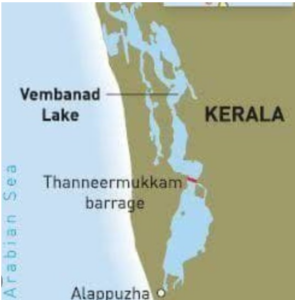
More About Water Hyacinth:
- Scientific Name: Eichhornia crassipes
- Origin: Native to the Amazon Basin in South America.
- Introduction: Introduced globally as an ornamental plant, now a widespread invasive species.
- Appearance: Characterised by broad, thick, glossy leaves, and striking lavender flowers. It can grow up to 1 metre in height.
- Reproduction: Reproduces rapidly through both seeds and vegetative parts, forming dense mats on water surfaces.
- Impact on Ecosystems:
- Blocks sunlight, reducing oxygen levels in water, which harms fish and other aquatic life.
- Provides breeding grounds for mosquitoes, increasing the risk of diseases like malaria and dengue.
- Economic Impact:
- Clogs waterways, affecting navigation, irrigation, and hydropower generation.
- Impedes fishing activities, impacting livelihoods.
- Control Measures:
- Mechanical removal, although labour-intensive and costly.
- Biological control using insects like weevils.
- Chemical control with herbicides, though it poses risks to non-target species and water quality.
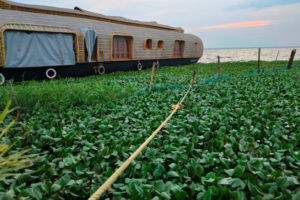
3. Advanced medium combat aircraft prototype expected to be ready by 2028-29
(Source – The Hindu, International Edition – Page No. – 4)
| Context |
|
Analysis of the news:
- The Defence Ministry is advancing the indigenous Advanced Medium Combat Aircraft (AMCA) project with significant private sector involvement for timely execution.
- The AMCA design is ready, with the first prototype expected by 2028-29 and production beginning by 2032-33.
- Induction is targeted for 2034, with private sector collaboration models to be finalised within six months.
- An Expression of Interest (EoI) has been issued, and three industry responses have been received.
- The AMCA is crucial as India’s only Fifth Generation Fighter Aircraft (FGFA) amid global FGFA advancements, especially with China’s J-20 FGFA deployment in Tibet.
- Sanctioned by the Cabinet Committee on Security (CCS) in March, the AMCA is a 25-tonne twin-engine stealth aircraft with internal weapons bay and diverterless supersonic intake.
- It features an internal payload capacity of 1,500 kg, external payload of 5,500 kg, and 6,500 kg of internal fuel.
- Hindustan Aeronautics Limited (HAL) is the production agency and has commenced manufacturing activities.


